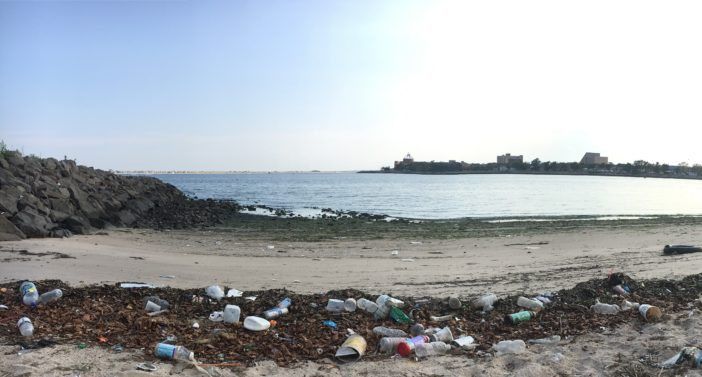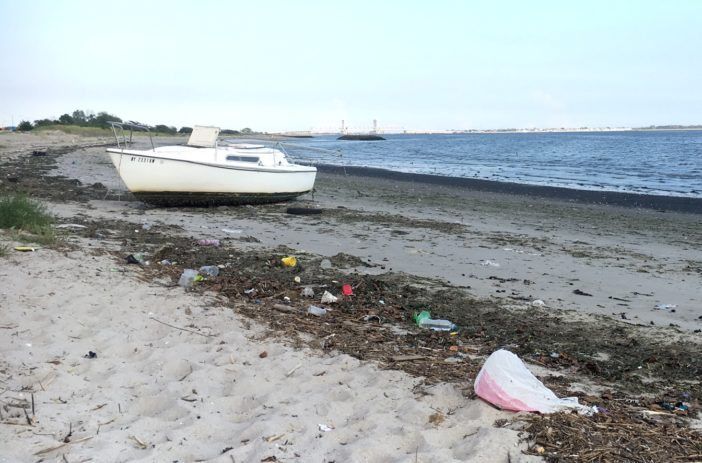Plumb Beach – Sheepshead Bay’s Rough Diamond

If you’re a South Brooklynite, chances are you’ve passed that beach right at the end of Emmons Avenue. Perhaps you’ve driven by as you enter the Belt Parkway, or biked that path on your way to Fort Tilden. It’s usually unpopulated and easily overlooked.
Plumb Beach has long been Sheepshead Bay’s source of contention. In the 1890’s the federal government decided to purchase 50 acres of land (Plumb Island and Hog Creek) but the beach was too sandy for its intended purpose – as a mortar battery to protect the harbor. Sheepshead Bay was one of the first fishing ports in the United States that catered to party boats, so the harbor was considered quite valuable. However, since there were no other federal plans to use the land, homeless vagrants moved in, selling cheap liquor and cigarettes. Efforts were occasionally made to clean up the beach, but the garbage quickly repopulates here and the sand dunes are a repository for organic trash as well.
Currently, it’s considered a part of the Gateway National Recreation Area. The shore was reknown for terrific windsurfing in the Summer and horseshoe crab mating season in the Spring, but by the late 1970s, it was also known as a dump year round.
[youtube https://www.youtube.com/watch?v=0rtT9aCmNcY?rel=0]
This 1977 news clip is still shockingly relevant – the contaminated water is still dangerous for swimming. A beautifully coiffed Marty Markowitz (Brooklyn’s past Borough President) points out that “it’s a lack of funds and a lack of commitment” from Washington. Research shows the restoration from the 2009 nor’easter was split: Sixty-five percent of the money from the federal government, and the rest from the city. Currently, maintenance for this area is minimal at best.
Wildlife in that area consists of over 300 bird species, about 100 fin-fish species, and a score of butterfly species, but most notable are the horseshoe crabs. In the past, horseshoe crabs (Limulus polyphemus) would frequent Plumb Beach in surprising numbers, but their count has severely dwindled. These prehistoric-looking arthropods have certainly earned their nickname of “living fossils” – they are part of a species over 450 million years old. The crabs return to their birth site and mate on the beach from late May to early June, but their populations are now much reduced throughout the region. A move in the early 1990s to replenish sand to Plumb Beach severely disrupted the habitat conditions for the horseshoe crabs, and they temporarily abandoned use of the beach. Between erosion and the health industry’s use (their blood is used to test patients for bacterial infections), the horseshoe crab is now a near-threatened species.

The habitat for human beings is not much more hospitable – the most convenient access to Plumb Beach is through a parking area off the eastbound Shore Parkway, and it’s well known as a dangerous, late-night spot for male sexual encounters. This became more widely known after the 2006 death of Michael Sandy, a gay man who had been lured there by four men intending to rob him. He was hit by a car on the Shore Parkway while trying to escape his attackers.
In 2015, HarborLAB proposed a dune-stabilization project that involved planting trees and shrubs that were native as well as salt and drought-tolerant. With approval from Gateway Park officials, they moved forward. Combining forces with NY District Division 11 Key Club high school students , friends from the Eastern Queens Alliance, and guided by Gil Lopez of Smiling Hogshead Ranch, volunteers from HarborLAB planted the donated hackberry and serviceberry trees, as well as beach plum seeds.
National Parks Service Public Affairs Daphne Yun says that “volunteers typically clean up this area. The next volunteer cleanup is scheduled for September 24th, working along with non-profit NYCH2O. If you would like to participate, please contact Keith White at keith_white@nps.gov.”



